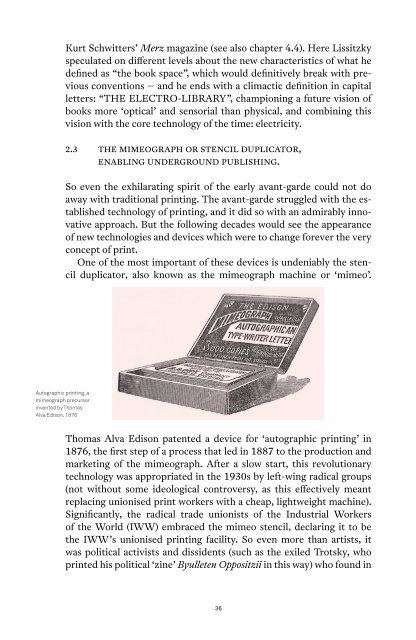Post- Digital Print - Monoskop
Post- Digital Print - Monoskop
Post- Digital Print - Monoskop
Create successful ePaper yourself
Turn your PDF publications into a flip-book with our unique Google optimized e-Paper software.
Autographic printing, a<br />
mimeograph precursor<br />
invented by Thomas<br />
Alva Edison, 1876<br />
Kurt Schwitters’ Merz magazine (see also chapter 4.4). Here Lissitzky<br />
speculated on different levels about the new characteristics of what he<br />
defined as “the book space”, which would definitively break with previous<br />
conventions – and he ends with a climactic definition in capital<br />
letters: “THE ELECTRO-LIBRARY”, championing a future vision of<br />
books more ‘optical’ and sensorial than physical, and combining this<br />
vision with the core technology of the time: electricity.<br />
2.3 the mimeograph or stencil duplicator,<br />
enabling underground publishing.<br />
So even the exhilarating spirit of the early avant-garde could not do<br />
away with traditional printing. The avant-garde struggled with the established<br />
technology of printing, and it did so with an admirably innovative<br />
approach. But the following decades would see the appearance<br />
of new technologies and devices which were to change forever the very<br />
concept of print.<br />
One of the most important of these devices is undeniably the stencil<br />
duplicator, also known as the mimeograph machine or ‘mimeo’.<br />
Thomas Alva Edison patented a device for ‘autographic printing’ in<br />
1876, the first step of a process that led in 1887 to the production and<br />
marketing of the mimeograph. After a slow start, this revolutionary<br />
technology was appropriated in the 1930s by left-wing radical groups<br />
(not without some ideological controversy, as this effectively meant<br />
replacing unionised print workers with a cheap, lightweight machine).<br />
Significantly, the radical trade unionists of the Industrial Workers<br />
of the World (IWW) embraced the mimeo stencil, declaring it to be<br />
the IWW’s unionised printing facility. So even more than artists, it<br />
was political activists and dissidents (such as the exiled Trotsky, who<br />
printed his political ‘zine’ Byulleten Oppositzii in this way) who found in<br />
36

















